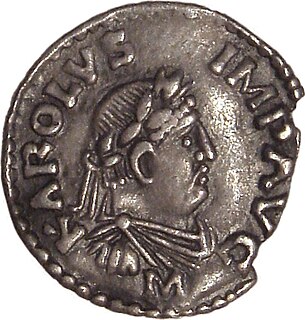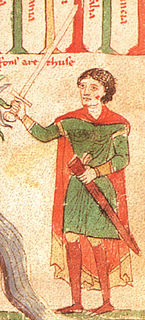William of Capparone was a German captain [1] of Palermo who came to power as the regent of Sicily and guardian of future emperor Frederick II in 1202 after the death of Markward von Anweiler. He held the post for the next four years until 1206. He was called the Great Captain.

The Holy Roman Emperor was the ruler of the Holy Roman Empire during the Middle Ages and the early modern period. The title was, almost without interruption, held in conjunction with title of King of Germany throughout the 12th to 18th centuries.

Palermo is a city of Southern Italy, the capital of both the autonomous region of Sicily and the Metropolitan City of Palermo. The city is noted for its history, culture, architecture and gastronomy, playing an important role throughout much of its existence; it is over 2,700 years old. Palermo is located in the northwest of the island of Sicily, right by the Gulf of Palermo in the Tyrrhenian Sea.
A regent is a person appointed to govern a state because the monarch is a minor, is absent or is incapacitated. The rule of a regent or regents is called a regency. A regent or regency council may be formed ad hoc or in accordance with a constitutional rule. "Regent" is sometimes a formal title. If the regent is holding his position due to his position in the line of succession, the compound term prince regent is often used; if the regent of a minor is his mother, she is often referred to as "queen regent".
William was probably supported by Pisans, for he dates certain instruments of Fredericks with the Pisan system. He certainly did not have the support of the Hohenstaufen family, of which the young Frederick was a scion. He was opposed also by Pope Innocent III, who tried to arrange a favourable marriage for Frederick to put him under somebody else's influence.

Pisa is a city and comune in Tuscany, central Italy, straddling the Arno just before it empties into the Ligurian Sea. It is the capital city of the Province of Pisa. Although Pisa is known worldwide for its leaning tower, the city of over 91,104 residents contains more than 20 other historic churches, several medieval palaces, and various bridges across the Arno. Much of the city's architecture was financed from its history as one of the Italian maritime republics.

The Hohenstaufen, also known as Staufer, were a dynasty of German kings (1138–1254) during the Middle Ages. Before ascending to the kingship, they were Dukes of Swabia from 1079. As kings of Germany, they had a claim to Italy, Burgundy and the Holy Roman Empire. Three members of the dynasty—Frederick I (1155), Henry VI (1191) and Frederick II (1220)—were crowned emperor. Besides Germany, they also ruled the Kingdom of Sicily (1194–1268) and the Kingdom of Jerusalem (1225–1268)

Pope Innocent III, born Lotario dei Conti di Segni reigned from 8 January 1198 to his death in 1216.
William's dictatorship in Sicily is shown in that it is known that he expelled Urso, Bishop of Agrigento, from his diocese (for the second time) for refusal to take an oath of fealty.
In Spring 1204, the pope's legate began negotiating for peace and the recognition of the pope's representatives. Capparone never fulfilled his end of the deal, however, and peace was ultimately not obtained. In 1206, William was finally removed from power and replaced by the chancellor Walter of Palearia. William still held the royal palace, however. With the aid of Diepold, Count of Acerra, he was eventually dislodged, as were his Pisan friends. The Genoese gained ascendancy in Sicilian trade thereafter.
Walter of Palear was the chancellor of the Kingdom of Sicily under Queen Constance and the Emperor Henry VI. He was also the bishop of Troia (1189–1208) and later bishop of Catania.
















